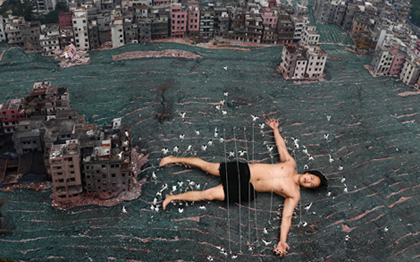Border Crossings
| April 14, 2011 | Post In LEAP 8

With four daily non-stops from Beijing to Taipei, twenty-four hour border crossings between Hong Kong and Shenzhen, and steady jetfoil service between Macau and cities along the Pearl River Delta, we find constant movement throughout “Greater China” today. Yet while the idea of “Greater China” carries with it a set series of associations— commercial, cultural, political— we rarely hear about how exchange between Mainland China, Taiwan, Hong Kong, and Macau influences the art of these distinct regions. Aptly premiering at He Xiangning Art Museum in Shenzhen’s “Overseas Chinese Town,” the “1+1” exhibition asks what “Greater China” means in terms of art production through the very specific act of pairing artists from different regions to create a single collaborative work.
1. Trilingua
Run by a pair of recent graduates from Hong Kong Polytechnic University, Trilingua is a design studio with a multidisciplinary approach, working in branding and print, packaging and environmental products, as well as web and interactive design. Trilingua has been selected to design the promotional materials for the “1+1” exhibition, taking the opportunity to visually map the cross-region collaborative exchanges between artists.
2. George Wong + Liu Liyun
George Wong of Hong Kong and Liu Liyun of the Mainland fashion two sculptures that resemble hanging human bodies, both filled with sand collected from Shenzhen, Hong Kong, and Taiwan, the three locations for the traveling exhibition. As time elapses, the sand gradually trickles out and collects on the exhibition floor, evoking a constant state of transformation and becoming.
3. Chih-Chien Chen + Wen Yau
Taiwanese video artist Chih-Chien Chen joins Hong Kong’s Wen Yau, who works primarily in film and installation art, and also serves as a researcher at the Asia Art Archive. Their collaboration, entitled “Square,” is composed of pin hole photographs, panorama views of architectural formations wrapped around cylindrical light boxes. The piece provokes discussions of an array of landmark events in the histories of Taiwan and Hong Kong.

4. João Ó Bruno Soares + Ming-Kuei Ho
Macau-based architect João Ó Bruno Soares also works in installation art, frequently addressing questions of self-identity and postcolonialism. Ming-Kuei Ho was originally at the National Taiwan Museum of Fine Arts, and has recently returned to creative production. Together, they have fashioned architectural structures and drawings that address notions of private space and personal origins.
5. Liang Yuanwei + Bai Xiaoci
Recent projects from these two Mainland Chinese artists have uncovered two profoundly intriguing obsessions : Liang Yuanwei’s with flowers, and Shenzhen-based Bai Xiaoci’s with government mega-structures (see both in LEAP 7). Their project for “1+1” works to locate the individual in relation to China’s transformations of lived space, mapping the process of demolition as a production of ruins with dramatic aesthetic implications on spaces of dwelling and objects of the everyday.
6. Chung-Han Yao + Rita Hui
“Two Cases” is the project from Taiwanese sound artist Chung-Han Yao and video artist Rita Hui from Hong Kong. In a cavernous, dark exhibition space, their project materializes as part video installation and part light installation. It explores the body and sexuality, calling attention to the rhythm, sound, and movement of the human form.

7. Kai-Ti Shan + Zhao Zhao
A recent graduate of the Taipei National University of the Arts, Kai-ti Shan is the youngest participating artist in the exhibition. She works primarily in video, often employing a self-reflexive approach as she explores her body and self-identity in her work. Zhao Zhao, born in Xinjiang and currently based in Beijing, has recently made a number of socially minded films under the tutelage of his mentor Ai Weiwei, as well as more conceptual sculptures and photographs.
8. Bai Qiang + Wu Jian’an
Macau-based Bai Qiang was trained as a graphic designer, and spent last year working on a number of painting projects on the Mainland. Wu Jian’an currently teaches at the Central Academy of Fine Arts in Beijing, where his work explores the dynamics of self-expression with recourse to the traditional craft of paper-cutting. The collaboration between the two artists produces a whimsical play of images, arranged like playing cards into gamelike scenarios that reflect art historical tropes and construct humorous juxtapositions as they make comments on contemporary Chinese society.


